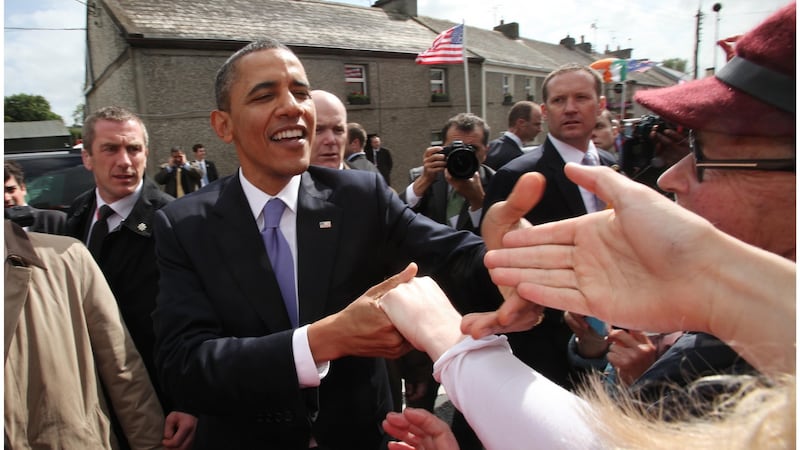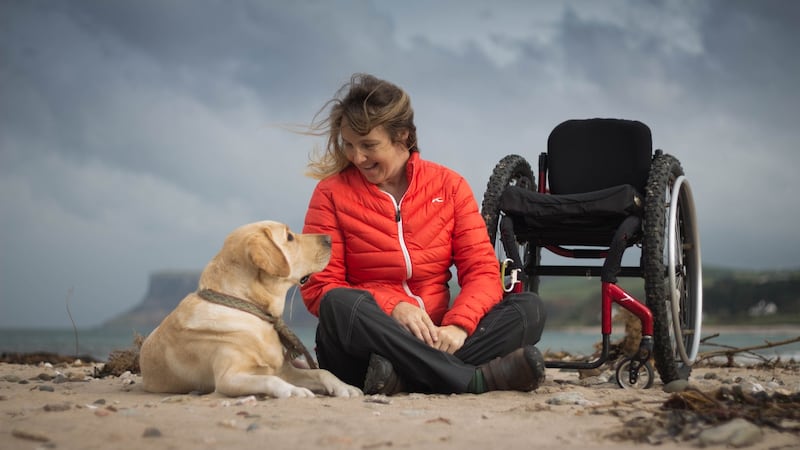There is a touchscreen in the research area at the Irish Family History Centre in the chq building in Dublin docklands that asks the question “Who are you?”
Few can resist the temptation to tap in their name in response, and if you succumb, before you know it, you’ll be hooked.
My own surname is deemed to be "rare", of English origin, and found in Armagh and Kilkenny. Spot on. My father's family have strong connections with the Border county, and more than 40 years ago, several family members migrated from there to Kilkenny.
An appointment with Fiona Fitzsimons, director of research at the centre, and Fiona O’Mahony, the centre’s manager, means I have to reluctantly abandon my brief foray into my personal family history, but it triggers a curiosity that I’ve never experienced before.
People use family history to better understand themselves - personal identity is a key thing
According to Fitzsimons, my response is typical. “People use family history for all kinds of things. They use it to better understand themselves – personal identity is a key thing. Sometimes they use it for entertainment. But the family history that we do is always underpinned by historical research methodology and documents.”
Research facilities
The Irish Family History Centre, which opened in 2016, is located alongside Epic, the Irish Emigration Museum, and is operated by Eneclann, a Trinity College campus company specialising in Irish historical research and genealogy. You can buy a joint ticket for both attractions, or pay €12.50 just to visit the Family History Centre and use its research facilities.
There are four genealogy experts attached to the centre who assist visitors with their research, and you can book one-to-one consultations with them (€45 for 30 minutes or €85 for an hour).
“It’s a little bit like going to a golf club and hiring a golf pro, you’ve got somebody there who is a professional, who knows the archives, knows what sources are, who has all the skills. There’s no real shortcut, but we will do it in a much more focused way,” says Fitzsimons, an academic and genealogist who is also general manager of Eneclann.
Irish roots
Those skills have been harnessed in the past to delve into the Irish roots of a variety of states people, actors and celebrities, including Barack Obama, Tom Cruise, Princess Charlene of Monaco and, most recently, Canadian prime minster Justin Trudeau.
The team had just five days to research Trudeau's Irish connections, through his mother, Margaret Sinclair. The work was done at the request of the Department of Foreign Affairs, and the team was able to present him with a 12-page family history, going back 10 generations to 17th century Ireland, when he attended Epic during his visit to Ireland last year.

"We took him back to the early 1600s, when the Bernard family first arrived in Munster, from England, " Fitzsimons says. "We traced back to a great – x6 – grandfather who entered Trinity in 1722 and who took seven years to complete his undergraduate degree, and he got a chuckle out of that."
Fitzsimons began working on Barack Obama’s Irish family history with fellow genealogist Helen Moss in 2008. “In technical terms, that was a beautiful piece of research. We took the family back to the 1690s. We incorporated a huge range of sources, and we found family who were still in the place, close cousins.”
When Obama visited Ireland in 2011, he was introduced to some of his relatives in Moneygall, including Henry Healy, his eighth cousin, who has been widely quoted in the media across the world on his relationship with the former US president.

But, according to Fiona Fitzsimons, he wasn’t the only relative Obama met on that visit to Moneygall. “Everyone knows about Henry Healy – Henry the eighth – but he was introduced to cousins who were a great deal closer.”
The former US president was shown around his ancestral home by its current owner, John Donovan, who had been briefed by Fitzsimons. “I met him down in Moneygall two days before the visit. I gave him the [family history] report and I walked around and I showed him what was what.
“Obama is a hard-nosed politician and he’s a lawyer and there’s not much of whimsy there, but apparently when he was inside in the house, he suddenly got it, and he asked what part of the house his ancestors would have lived in. I’d anticipated this question and I drew something to show him what the house was like when his ancestors lived in it.”
The former US first family's connections with Ireland were further explored in 2013, when Michelle Obama visited with their daughters, Malia and Sasha. "We were asked by the White House to present the girls with their family history. Mrs Obama was the one who dictated the terms, and she specifically asked that it was geared towards her girls; she wanted them to have a sense of their Irish heritage."
On hearing that their Moneygall ancestors had been wig makers and shoe makers, Fitzsimons says Mrs Obama’s response was “Hair and shoes, well girls, we like those, don’t we?”
Cruise’s exploration
Researching the actor Tom Cruise’s Irish ancestry in 2013 became one of the most significant family history explorations Fitzsimons has been involved in. “We traced him back to, believe it or not, 919. He fed into one of the great Gaelic genealogies . . . To be able to trace a family over 1,000 years is something quite exceptional.
“We spent almost an hour with him, explaining his family history. He was so interested he stayed on much longer than his time schedule allowed for. He’s a really bright guy, he got it and he asked really good questions. We got feedback that it actually gave him something to be really proud of in his family life.”
One of the things family history allows you to do is to move beyond the elite
But it’s not just the famous names that Fitzsimons is interested in, and she is keen to stress that the centre is for everyone.
“One of the things family history allows you to do is to move beyond the elite. You’ll find them in the history books and the text books, they’re very well documented because they leave a paper trail – they have resources, they have land. But family history allows you to look at the greater population that don’t normally get a look in.”
“Computerisation and the digitalisation of records has fuelled interest in genealogy,” Fitzsimons believes. “We’ve had a digital revolution in Irish family history. When I started out, there were no records online at all and there are now over 150 million Irish records available. It’s the accessibility of the records that’s the big driver.”
Eneclann has worked with the Irish, British, Australian and Canadian productions of the TV show, Who Do You Think You Are, and Fitzsimons thinks that programmes such as this, and personal histories done on behalf of high profile personalities, "sharpen people's interest".
“But what people are really intrigued by is, ‘Can I do it?’ They understand that everyone has a personal narrative, every family has a story.”
Uncovering her past: Chris Slavin
Chris Slavin, who lives in Danvers, Massachusetts, says she "saved her First Communion money to go to Ireland". Her interest in the country was sparked by her grandparents, both of Irish decent, with whom she lived from the age of 12 into adulthood.

She finally made it in 1993, aged 23, and since then has visited Ireland “at least 12 times”. On each trip, she makes time for a visit to the Irish Family History Centre, where she has been working on discovering more about her ancestry.
Her first visit to Ireland made a deep impression. “I stepped foot on the ground and I somehow just felt like it was – it’s so hard to explain, the cellular connection – like I belong here and these are my people.”
But there was a 10-year period when she felt unable to return to Ireland. “Originally, I would come to Ireland and I would spend a couple of months and I would walk or hike all over Ireland and I would go to all the ceilis.
“I was a competitive snowboarder, and I had a spinal cord injury in an accident competing at our nationals. Then I became a Paralympic level mono-skier. I did that for eight years and I was really involved in that, and I didn’t go back to Ireland. I just couldn’t. I couldn’t emotionally face the idea. I couldn’t even listen to Irish music.
“Then I got my service dog, Earle, and at that time I just had this call to go back. I said, it’s not going to be the same, but it’s okay that it’s not the same.”
Maiden names
In January of this year, she came armed with new information. Her grandmother’s sister, her great aunt Eleanor, had recently passed away. “And in her things we found two birth certificates and they had some names on them that were from my grandmother’s side – we’d never been able to find maiden names before,” Slavin explains.
With the assistance of the centre manager Fiona O’Mahony, Slavin delved deeper into her grandmother’s ancestry, and was able to discover, through parish records, that her grandmother’s great grandparents, James Doran and Ann Conlon, were from the village of Derrynoose in the parish of Keady, Co Armagh. They left Ireland in 1871 and settled in the US.
“When I finally saw the names on the screen, on the parish record, I started crying, because I’d been searching for so long. Once we found it, all I wanted to do was go to Armagh.” Slavin plans to return to Ireland later this year to make that journey.
She says that people ask her why she is so driven to come back to Ireland so often, and her reply is: “ I think it comes down to my family didn’t leave because they wanted to leave.”
Personal project: Fiona O’Mahony
Fiona O’Mahony, manager of the Irish Family History Centre, encounters people with varying degrees of interest and expertise visiting the facility at Custom House Quay in Dublin 1.
There are people who say “I don’t know anything, but I’d like to know something”, as well as others who come armed with significant amounts of information. “They’ve got to a certain point and they just want to know how to get a bit further.”
She recently used the research facilities and her own research skills to pursue a personal project.
“My great grandmother, my father never knew where she was buried, because she refused to be buried with my great grandfather. My father is 85 next month and he had this thing in his head, he wanted to know where she was buried.”
O’Mahony began researching her great grandmother. “With Find My Past, I was able to get the Index of Irish Wills.” She located her relative’s will and went to the National Archives of Ireland, in Dublin, to read it.
“In the will it said who the undertakers were, and the payment to the undertakers. I rang the undertakers, they had the record, and they told me what graveyard she was buried in and they gave me the name of the groundskeeper.”
O’Mahony now plans to take her father to visit the grave.





















